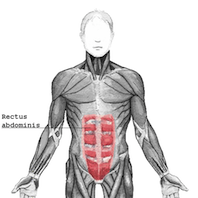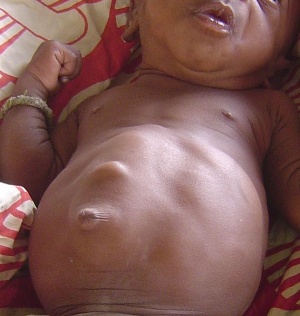Diastasis Recti Abdominis: Difference between revisions
Nicole Hills (talk | contribs) mNo edit summary |
Nicole Hills (talk | contribs) No edit summary |
||
| Line 74: | Line 74: | ||
|- | |- | ||
| {{#ev:youtube|5oslM6Pe9AU|300}}<ref name="vid1">Diane Lee. Integrated Systems Model for Physiotherapy in Womens' Health. Available from: http://www.youtube.com/watch?v=5oslM6Pe9AU [last accessed 8/2/15]</ref> | | {{#ev:youtube|5oslM6Pe9AU|300}}<ref name="vid1">Diane Lee. Integrated Systems Model for Physiotherapy in Womens' Health. Available from: http://www.youtube.com/watch?v=5oslM6Pe9AU [last accessed 8/2/15]</ref> | ||
|}<div class="researchbox"> | |}<div class="researchbox"> | ||
Revision as of 18:06, 22 June 2018
Original Editor - Marianne Ryan
Top Contributors - Nicole Hills, Sivapriya Ramakrishnan, Lucinda hampton, Admin, Vidya Acharya, Victoria Geropoulos, Regan Haley, Rachael Lowe, Laura Ritchie, Marianne Ryan, Oyemi Sillo, Kim Jackson, Michelle Walsh, WikiSysop, Tarina van der Stockt and Claire Knott - Your name will be added here if you are a lead editor on this page.
Description[edit | edit source]
Diastasis recti or diastasis recti abdominis is a separation of the rectus abdominal muscles at the linea alba[1]
Clinically Relevant Anatomy[edit | edit source]
The two rectus abdomins muscle heads run parallel to each other and are separated by a connective tissue along the midline of the body called the linea alba.[2] The distance between the rectus abdominis muscles is referred to as the inter-rectus distance. A patient is considered to have a diastasis recti when they present with an 'abnormal' inter-rectus distance or diastasis recti. On palpation if a therapist can place two or more finger breaths (≈2cm) in the sulcus between the medial borders of the rectus abdominus muscles the patient may present with diastasis recti.[3] Palpation, in clinical practice, appears to be sufficient for detecting the presence or absence of diastasis recti,[4] however ultrasound imaging can produce a more precise measurement.[4]
Mechanism of Injury / Pathological Process[edit | edit source]
Diastasis recti can occur as result of prolonged transverse stresses on the linea alba in men,[5] postmenopausal women,[6] and in women during pregnancy. [7][8]
Diastasis recti can also occur in newborns and in this population is defined as an inter-rectus distance greater than 3cm.[9]
Clinical Presentation[edit | edit source]
Management / Interventions[edit | edit source]
Abdominal Binders[edit | edit source]
Binders do have a place in the treatment of the condition, but the wrong or overuse of them can cause more problems. It is best not to use an abdominal binder unless absolutely necessary, for example during pregnancy in the third trimester and 6 weeks after delivery if there is a separation of 2 fingers or more.
Belly Band[edit | edit source]
Wearing a belly band during pregnancy (one made specifically for pregnant women) will help increase proprioception and muscle awareness. A belly band or tight tube top can be used after childbirth for the same reasons.
Kegel Exercises[edit | edit source]
Pelvic floor exercises will help strengthen deep abdominal muscles
because all the core muscles contract automatically as a cohesive group. These exercises can be performed through out pregnancy and may be started in the early postpartum period.
Breathing Exercises[edit | edit source]
Breathing exercises help to retrain the diaphragm to relearn how to descend after childbirth. During pregnancy the diaphragm is pushed upwards by the growing uterus and loses its ability to descend during inhalation. Since the diaphragm forms the top of the core muscles, it is important to retrain it to function with a full excursion again. Here are 2 good exercises
- Inverted Breathing - Lie supine with the buttock on a pillow wedge, raised above chest level. Teach patient to take short shallow breaths “through the pelvic diaphragm”. Have patient place one hand just above the pubic symphysis and teach them to feel for a slight up and down motion while they breathe in and out. Place the patients other hand on top of their chest and tell them to try not to have their chest rise when breathing.
- Lateral Costal Breathing - In the seated position have patient place their hands on the lateral sides of the rib cage. Teach them to “breathe into their hands” and to feel for the lateral expansion of the rib cage as they inhale and the movement of the ribcage toward the midline during exhalation.
Progressive Core Exercises[edit | edit source]
There are several exercise that can be used to help restore core strength which will help close the gap in a diastasis. For more detail refer to Diane Lee’s well-published work on the Diastasis Recti.
| [10] | [11] |
Sit-Ups and Crunches[edit | edit source]
Teach patient not to do sit-ups or other crunches to strengthen the abdominal muscles. Sit-ups and similar exercises put a great deal of strain on the pelvic floor and can cause further separation of the abdominal muscles and should be avoided in the prenatal and post-partum phases.
Body Mechanics[edit | edit source]
It is important to teach patient how to perform ADL’s without increasing abdominal pressure, such as rolling out of bed, instead of doing a “sit-up” to get up. Avoid “jack-knifing” behavior that increases intra-abdominal pressure. Other activities to watch out for is getting out of a bath, lifting and carrying older children and heavy objects during pregnancy and the early postpartum period. Teach them to “exhale as you lift.”
Postural Awareness[edit | edit source]
After pregnancy women tend to stand with and an exaggerated anterior pelvic tilt and with their pelvis pushed forward. In order to stand up against gravity their bodies typically develop areas of rigidity in upper lumbar and lower thoracic area along with the buttock muscles. Diane Lee refers to this as “back clenching and buttock griping behavior.” Manual therapy and relaxation exercises must be used prior to strengthening exercises. (http://dianelee.ca/articles/UnderstandYourBack&PGPopt.pdf)
| [12] |
References[edit | edit source]
- ↑ Gilleard WL, Brown JM. Structure and function of the abdominal muscles in primigravid subjects during pregnancy and the immediate postbirth period. Physical therapy. 1996 Jul 1;76(7):750-62.
- ↑ Peterson-Kendall F, Kendall-McCreary E, Geise-Provance P, McIntyre-Rodgers, Romani W. Muscles: Testing and Function, with Posture and Pain. 5th ed. Baltimore: Wolters Kluwer; 2005.
- ↑ Noble E. Essential Exercises for the Childbearing Year. 2nd editio. Boston, MA: Houghton Miffilin; 1982.
- ↑ 4.0 4.1 Van de Water AT, Benjamin DR. Measurement methods to assess diastasis of the rectus abdominis muscle (DRAM): a systematic review of their measurement properties and meta-analytic reliability generalisation. Manual therapy. 2016 Feb 1;21:41-53.
- ↑ Lockwood T. Rectus muscle diastasis in males: primary indication for endoscopically assisted abdominoplasty. Cosmetic. 1998;May:1685-1691.
- ↑ Spitznagle TM, Leong FC, Van Dillen LR. Prevalence of diastasis recti abdominis in a urogynecological patient population. International Urogynecology Journal. 2007 Mar 1;18(3):321-8.
- ↑ Akram J, Matzen SH. Rectus abdominis diastasis. Journal of plastic surgery and hand surgery. 2014 Jun 1;48(3):163-9.
- ↑ Brauman D. Diastasis recti: Clinical anatomy. Plastic and reconstructive surgery. 2008 Nov 1;122(5):1564-9.
- ↑ Marden PM, Smith DW, McDonald MJ. Congenital anomalies in the newborninfant, including minor variations: A study of 4,412 babies by surface examination for anomalies and buccal smear for sex chromatin. The Journal of pediatrics. 1964 Mar 1;64(3):357-71.
- ↑ Fit Healthy Moms. 3 Ab Exercises to Heal Diastasis Recti. Available from: http://www.youtube.com/watch?v=Q6SfiH2-TEQ [last accessed 25/05/13]
- ↑ MomsIntoFitness. Diastasis Recti Exercises 5 min Core Workout : DVD. Available from: http://www.youtube.com/watch?v=6mpd3EVRaO4 [last accessed 25/05/13]
- ↑ Diane Lee. Integrated Systems Model for Physiotherapy in Womens' Health. Available from: http://www.youtube.com/watch?v=5oslM6Pe9AU [last accessed 8/2/15]








